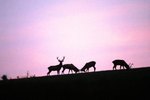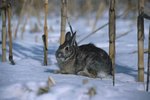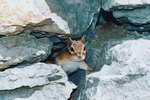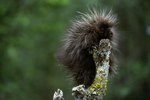
Marshy sections of land in or near a forest may be the work of a group of beavers, the largest rodents in North America. Big piles of sticks chewed to points at the ends are likely beaver houses. A second pile of branches nearby is probably the beavers' pantry. Beavers begin storing food in the water near their homes in late summer so they have something to eat throughout the winter. The whole family shares in the work and the food, young and old alike.
Beaver Basics
The beaver has prominent buckteeth and a broad tail. The rodent can weigh as much as 75 pounds and measure 4 feet long. The beaver’s outer coat is brown, the thick undercoat is gray. Babies are born looking much like the adults, complete with fur and with eyes that are already partway open. A newborn beaver is smaller than an adult is, but is still good-sized at about a foot long. They little ones, called kits, aren’t quite ready to take care of themselves, but both parents will make sure they are fed and cared for as long as necessary.
First Foods for the Kids
Beavers are mammals; the mother feeds her babies milk when they are very young. The kits don’t eat anything else at first, but they begin to try other foods as they grow. Both parents work together to raise the young, bringing the babies fresh branches and leaves to nibble on when they are between 2 and 3 weeks old. They will teach the kits how to eat the soft inner layer of bark from maple and other trees, along with cattails, grass, ferns and mushrooms. Babies typically wean by the time they are 6 weeks old.
Expanding Diets
Young beavers learn from their parents which foods are good to eat and which to avoid. One of the staples of the kit’s diet is the cambium, the soft bark found underneath the tough outer bark of trees and woody bushes. Deciduous trees make up most of a beaver’s diet in the fall and winter, with trees less than 6 inches in diameter preferred over bigger ones. Favorite trees include willow, alder and aspen. In spring and summer, kits learn to eat tubers and shoots from plants such as cattail and pond lilies.
Stored Food
Beavers make a safe place for themselves and their families by building homes known as lodges from branches and limbs they collect. They gain entrance to their lodges by diving into the water and swimming up through underwater holes to the dry part inside. Beaver pairs raise one litter of babies in their lodge every year, usually sharing the space with other relatives in a group called a colony. The adults can safely swim out and get food for themselves and their kits from the stockpile of branches stored close to the lodge, even in bad weather.
References
Photo Credits
-
Hemera Technologies/Photos.com/Getty Images




